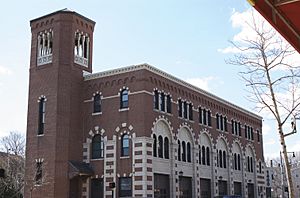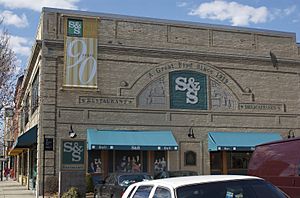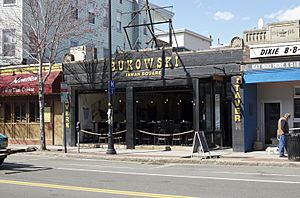Inman Square facts for kids
Quick facts for kids |
|
|
Inman Square Historic District
|
|
 |
|
| Location | Cambridge, Massachusetts |
|---|---|
| Architect | Newhall & Blevins; Atlantic Terra Cotta Company |
| MPS | Cambridge MRA |
| NRHP reference No. | 82001951 |
| Added to NRHP | April 13, 1982 |
Inman Square is a lively neighborhood and a historic area in Cambridge, Massachusetts. It's located north of Central Square. You can find it where Cambridge, Hampshire, and Inman Streets meet, close to the border with Somerville.
Contents
Where is Inman Square Located?
Like many "squares" in the Boston area, Inman Square is both a busy intersection and a place with shops and homes. People who live here usually think of Inman Square as the whole area around the crossing of Cambridge and Hampshire Streets.
This area is part of the larger Boston Basin, a low-lying region called the Cambridge Plain. Long ago, this land was flat and surrounded by swamps. Inman Square is quite central within the Mid-Cambridge/Somerville area. It's a short walk east of Harvard Square and north of Central Square. It's also south of Union Square and west of East Cambridge. Hampshire Street connects Inman Square to Porter Square in the northwest and Kendall Square in the southeast.
The History of Inman Square
Early Days: The 18th Century
Inman Square probably got its name from Ralph Inman (1713–1788). He was a wealthy merchant from Boston. He owned a lot of land, including about 400 acres (1.6 km2) in what is now the Port area.
Inman also had a large, three-story house in Cambridge. He described Cambridge as a "little genteel Town" where many wealthy families lived. This included the Brattle family, who gave their name to Brattle Square.
During the American Revolutionary War in 1775, American General Israel Putnam used Inman's house as his headquarters. Ralph Inman wanted to stay neutral in the war. However, his son joined the British Army, which led to authorities taking Inman's property. He left, leaving his wife, Elizabeth Murray, to deal with General Putnam and protect their home.
Elizabeth Murray, Inman's second wife, was a successful businesswoman herself. She owned a sugar warehouse in Boston. British troops took over this warehouse as a barracks before they marched to the Battles of Lexington and Concord. When her husband fled to Boston for British protection, Elizabeth Murray stayed in Cambridge to protect their property. After the Battle of Bunker Hill, the American army took over the property. Her husband then fled with the British to Halifax. Elizabeth stayed in America until she passed away in 1785.
Inman's house was described as "the first object of any interest in approaching the colleges from Boston." Ralph Inman died there in 1788.
Growing Up: The 19th Century
Inman Square began to grow around 1790, thanks to the development of East Cambridge. A group of investors, led by Andrew Craigie, bought land near Lechmere Point. Their goal was to build a toll bridge over the Charles River.
After Craigie's bridge was built, he created new roads from the Lechmere area. One of these was the Middlesex Turnpike, which is now Hampshire Street. This road connected Cambridge with Lowell and Boston, bringing a lot of traffic through the area. Craigie also planned Cambridge Street. These two roads crossed, creating Inman Square in 1809.
By the 1860s, horse carts were common, and homes started to appear along their routes. By 1900, streetcar service was available. The Charles River Street Railway built its first railway through Inman Square in 1881. By 1874, the area was an urban center known as both "Atwood's Corner" and "Inman Square." A year later, a petition officially named it Inman Square.
Modern Times: The 20th Century
Once transportation brought people and businesses, Inman Square became a stable neighborhood. From 1910 to the early 1950s, streetcars, cars, and people on foot moved through the square. During this time, many businesses opened to serve the local community. These included drugstores, taverns, markets, bakeries, delis, and insurance companies.
After the streetcars left Cambridge Street around 1950, the square became "a little bit out of the way." Still, it remained close to Harvard, Central, Kendall, and Lechmere. Even without direct subway access, three MBTA bus lines (69, 83, 91) stop in the square. This makes it easy to reach by public transport. People still visit the area's restaurants and entertainment spots regularly.
The popular restaurant chain Legal Sea Foods started in Inman Square in 1950. It began as a fish market that also offered takeout. Legal Sea Foods grew into a chain of many restaurants. After the original Inman Square location burned down, it was rebuilt as Cambridge Family Health. A decorative fish on the building at 237 Hampshire Street reminds people of the old fish market.
From the 1960s to the late 1970s, the improvisational comedy group The Proposition was located next to Legal Seafoods. Famous actors like Josh Mostel and Jane Curtin were part of this group. Later, in the 1980s, the Ding Ho restaurant at 11 Springfield Street became a place where comedians got their start. These included Steven Wright, Jimmy Tingle, Bobcat Goldthwait, and Barry Crimmins. Even future Tonight Show host Jay Leno performed there.
Today: The 21st Century
Inman Square is a neighborhood with many different cultures. It's home to professionals, working people, and students and professors from nearby MIT and Harvard. Inman Square also has strong Brazilian and Portuguese influences. You can see this in the shops along Cambridge Street, especially east of Prospect Street.
Boston's oldest continuous improvisational theater group, ImprovBoston, moved in 2008. It moved from its long-time home in Inman Square to Prospect Street in nearby Central Square.
Inman Square was also home to the Center for New Words, which was originally the New Words Bookstore. This was one of the oldest women's bookstores in the country. It was located at 186 Hampshire Street but closed its retail business in the early 2000s. From 2003 to early 2006, the Zeitgeist Gallery was at 1353 Cambridge Street. This gallery was run by artists, musicians, and activists. It was a center for art, music, and community events, supporting new and experimental work.
A related place called Zeitgeist Outpost, or Outpost 186, was opened by former Zeitgeist volunteers. It is now on the other side of Inman Square. It's actually in the back room of the old New Words bookstore, where the women's bookstore used to hold poetry readings and concerts.






